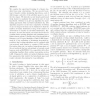Free Online Productivity Tools
i2Speak
i2Symbol
i2OCR
iTex2Img
iWeb2Print
iWeb2Shot
i2Type
iPdf2Split
iPdf2Merge
i2Bopomofo
i2Arabic
i2Style
i2Image
i2PDF
iLatex2Rtf
Sci2ools
87
Voted
SDM
2007
SIAM
2007
SIAM
Boosting Optimal Logical Patterns Using Noisy Data
We consider the supervised learning of a binary classifier from noisy observations. We use smooth boosting to linearly combine abstaining hypotheses, each of which maps a subcube of the attribute space to one of the two classes. We introduce a new branch-and-bound weak learner to maximize the agreement rate of each hypothesis. Dobkin et al. give an algorithm for maximizing agreement with real-valued attributes [9]. Our algorithm improves on the time complexity of Dobkin et al.’s as long as the data can be binarized so that the number of binary attributes is o(log of the number of observations × number of real-valued attributes). Furthermore, we have fine-tuned our branch-and-bound algorithm with a queuing discipline and optimality gap to make it fast in practice. Finally, since logical patterns in Hammer et al.’s Logical Analysis of Data (LAD) framework [8, 6] are equivalent to abstaining monomial hypotheses, any boosting algorithm can be combined with our proposed weak learner...
Related Content
| Added | 30 Oct 2010 |
| Updated | 30 Oct 2010 |
| Type | Conference |
| Year | 2007 |
| Where | SDM |
| Authors | Noam Goldberg, Chung-chieh Shan |
Comments (0)

